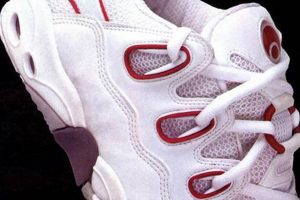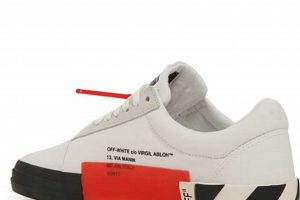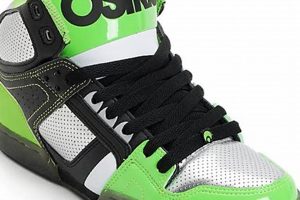Footwear designed to provide enhanced grip and traction while skateboarding is a necessity for practitioners of the sport. These specialized shoes incorporate outsole materials and tread patterns engineered to minimize slippage between the shoe and the skateboard, or other surfaces. An example would be a shoe with a vulcanized rubber sole featuring a herringbone or waffle pattern.
The advantages of footwear that maximize grip are numerous, including improved board control, enhanced safety, and increased performance capabilities. Historically, modifications were made to conventional athletic shoes in an effort to improve their suitability for skateboarding, but the development of specialized footwear has been pivotal to the evolution and progression of the sport.
The following sections will delve into the specific characteristics, construction materials, and design considerations that contribute to superior traction in skateboarding footwear, exploring their impact on both amateur and professional-level skaters.
Considerations for Traction-Optimized Skate Footwear
Selecting the appropriate footwear is crucial for skateboarders seeking enhanced grip and control. This section outlines key considerations to ensure optimal performance and safety.
Tip 1: Outsole Material Selection: Vulcanized rubber is generally preferred due to its inherent grip properties and flexibility. Gum rubber compounds often provide superior traction compared to harder rubber formulations.
Tip 2: Tread Pattern Examination: Deep, multi-directional tread patterns, such as herringbone or waffle designs, maximize surface contact and channel away water and debris, enhancing grip.
Tip 3: Sole Construction Assessment: Look for footwear with soles that are securely bonded to the upper, minimizing the risk of separation during high-impact maneuvers.
Tip 4: Upper Material Durability: While not directly related to grip, a durable upper, such as suede or reinforced canvas, provides necessary support and protection, contributing to overall control.
Tip 5: Fit and Comfort Considerations: Properly fitted footwear allows for optimal board feel and control. Ensure the shoe is snug but not constricting, permitting natural foot movement.
Tip 6: Break-In Period: New footwear may require a break-in period to achieve optimal flexibility and grip. Skate in the footwear regularly to soften the sole and enhance its adherence.
Tip 7: Regular Cleaning and Maintenance: Keep the soles clean from dirt and debris to maintain maximum grip. Use a stiff brush and mild detergent to remove build-up.
By considering these factors, skateboarders can select footwear designed to enhance grip, control, and overall performance. Prioritizing these elements contributes to a safer and more enjoyable skateboarding experience.
The following section will explore specific technologies and innovations in the field of skateboarding footwear, further enhancing traction and performance.
1. Vulcanized Rubber Outsoles
Vulcanized rubber outsoles represent a significant design element in footwear intended to provide enhanced grip, particularly in the context of skateboarding. The vulcanization process fundamentally alters the properties of raw rubber, resulting in a material well-suited for demanding applications.
- Enhanced Friction Coefficient
The vulcanization process cross-links the polymer chains within the rubber compound, increasing its resistance to deformation. This results in a higher coefficient of friction compared to non-vulcanized rubber, improving grip on various surfaces, including the griptape of a skateboard. For instance, a shoe featuring a vulcanized outsole will exhibit less slippage than one with a non-vulcanized sole under similar conditions.
- Improved Durability and Abrasion Resistance
Vulcanization strengthens the rubber, making it more resistant to wear and tear. This is crucial for skateboarding footwear, which is subjected to significant abrasion from the skateboard’s griptape and contact with the ground. A vulcanized outsole can withstand more use before wearing down, extending the lifespan of the shoe.
- Flexibility and Board Feel
While providing increased grip and durability, vulcanized rubber also retains a degree of flexibility, which is essential for skateboarders to maintain a good “board feel.” This allows skaters to sense the position and movement of the board under their feet, enabling precise control. For example, if the outsole were too rigid, the skater would lose sensitivity to the board’s movements.
- Bonding Strength with Shoe Uppers
The vulcanization process also allows for a strong chemical bond between the rubber outsole and the upper materials of the shoe. This bond is critical to prevent separation of the sole from the upper during the high-impact maneuvers associated with skateboarding. A weak bond compromises the structural integrity of the shoe and reduces its effectiveness in providing grip and support.
The combined effect of increased friction, durability, flexibility, and bonding strength underscores the importance of vulcanized rubber outsoles in skateboarding footwear designed to maximize grip and minimize slippage. Their continued prevalence in this specialized footwear category demonstrates their effectiveness in meeting the specific demands of the sport.
2. Herringbone Tread Patterns
Herringbone tread patterns, characterized by their distinctive V-shaped repeating design, are a common feature in specialized footwear designed to enhance grip and minimize slippage, particularly in skateboarding applications. Their implementation in the outsoles of these shoes contributes significantly to overall traction performance.
- Enhanced Multi-Directional Grip
The angled grooves inherent in the herringbone pattern provide superior grip in multiple directions, unlike linear tread designs. This is crucial for skateboarding, where riders experience forces from various angles during maneuvers. For example, when performing a kickflip, the foot applies pressure both laterally and longitudinally; the herringbone pattern facilitates grip in both axes.
- Effective Water and Debris Displacement
The V-shaped channels efficiently evacuate water, dirt, and small debris from the contact area between the shoe and the board’s griptape. This ensures a more consistent and reliable grip, even in less-than-ideal environmental conditions. Without effective displacement, a thin layer of contaminants can significantly reduce friction, leading to slippage.
- Optimized Surface Contact Area
The design of herringbone patterns maximizes the amount of rubber in contact with the surface. This increased contact area translates directly to greater frictional force and improved adherence. In contrast to smooth outsoles, the texture provided by the herringbone pattern allows the rubber to interlock with the irregularities of the griptape, enhancing the bond.
- Wear Resistance and Longevity
The robust nature of the herringbone design contributes to the outsole’s overall durability. The angled pattern distributes stress more evenly across the sole, reducing localized wear and tear. This extended lifespan is particularly advantageous for skateboarding footwear, which undergoes considerable abrasion.
The integration of herringbone tread patterns into skateboarding footwear exemplifies a deliberate engineering approach to optimize traction. The combination of multi-directional grip, efficient displacement of contaminants, maximized surface contact, and improved wear resistance renders this design a practical and effective solution for minimizing slippage and enhancing board control.
3. Gum Rubber Compounds
Gum rubber compounds play a critical role in specialized skateboarding footwear designed for superior grip. The fundamental property of gum rubber lies in its inherent stickiness, resulting from its specific formulation and manufacturing processes. This characteristic translates directly into an elevated coefficient of friction when in contact with the griptape surface of a skateboard. Footwear incorporating gum rubber outsoles exhibits a demonstrably stronger adhesive force, effectively minimizing slippage and enhancing board control. A clear example is the observation that skaters using shoes with gum rubber soles experience a reduced incidence of accidental foot displacement during technical maneuvers, allowing for more consistent trick execution. The importance of this enhanced grip is readily apparent when considering the high-speed, dynamic nature of skateboarding; even slight slippage can compromise a rider’s stability and lead to falls.
The practical application of gum rubber extends beyond basic traction. Its pliability also contributes to enhanced “board feel,” allowing skaters to more intuitively sense the board’s position and respond to subtle changes in momentum. This improved tactile feedback is crucial for fine-tuning movements and executing complex tricks with precision. Furthermore, variations in gum rubber compound formulation allow manufacturers to fine-tune the grip characteristics to cater to different skateboarding styles or environmental conditions. For example, some formulations may prioritize maximum stickiness for dry surfaces, while others might be designed to maintain grip in damp or oily environments.
In summary, gum rubber compounds represent a significant advancement in the design of skateboarding footwear. Their contribution extends beyond simply preventing slippage; they enhance board control, improve tactile feedback, and allow for customization based on specific performance requirements. While challenges remain in optimizing the durability of gum rubber without compromising its grip properties, its continued use in high-performance skateboarding shoes underscores its practical significance and value to riders of all skill levels.
4. Reinforced Sole Bonding
Reinforced sole bonding is a critical, though often overlooked, element in the construction of footwear designed to minimize slippage, particularly in the context of skateboarding. The integrity of the bond between the outsole and the shoe’s upper directly influences the shoe’s ability to maintain consistent contact with the skateboard’s griptape. A compromised bond introduces instability, potentially leading to unpredictable foot movements and a reduction in board control, effectively negating the benefits of a high-traction outsole material. For instance, if the sole begins to separate from the upper during a forceful landing, the skater’s ability to maintain balance and execute the trick is severely compromised. This separation introduces a point of instability, hindering the performance of maneuvers.
The selection of appropriate bonding agents and application techniques is paramount to achieving reinforced sole bonding. Manufacturers employ various methods, including chemical adhesives, stitching, and vulcanization, each contributing to the overall strength and durability of the bond. Shoes subjected to rigorous testing and quality control procedures demonstrate a significantly lower incidence of sole separation, ensuring consistent performance and minimizing the risk of accidents. An example is the use of specialized epoxy adhesives that create a flexible yet robust bond, capable of withstanding the constant flexing and impact forces encountered during skateboarding. Shoes with robust sole bonding contribute to the overall safety and efficacy of the footwear.
In summary, reinforced sole bonding is an indispensable feature of footwear intended to provide enhanced grip. A strong, durable bond between the outsole and the upper ensures consistent contact with the skateboard, maximizing control and minimizing the risk of slippage. While advancements in outsole materials and tread patterns contribute to traction, their effectiveness is contingent upon the structural integrity provided by reinforced sole bonding. The reliability and durability of the bond remain a critical factor in evaluating the overall performance and safety of such footwear. The absence of such bonding compromises the very functionality of the shoe.
5. Board Feel Sensitivity
Board feel sensitivity, the skater’s ability to perceive subtle nuances in the skateboard’s movement and orientation, is intrinsically linked to the effectiveness of footwear designed to minimize slippage. The design attributes promoting enhanced grip must not compromise the tactile feedback necessary for optimal control. This interplay between adhesion and sensitivity dictates the skater’s capacity to execute complex maneuvers and maintain stability.
- Outsole Thickness and Construction
Excessively thick or rigid outsoles can attenuate board feel, hindering the skater’s ability to sense subtle changes in the board’s angle and pressure distribution. Conversely, thin, flexible outsoles, while maximizing sensitivity, may sacrifice durability and protection. The ideal balance involves a carefully engineered outsole that provides sufficient cushioning and abrasion resistance without unduly dampening tactile feedback. For instance, a shoe with a thin vulcanized sole might offer excellent board feel but wear out quickly, while a cupsole construction might provide more protection at the cost of some sensitivity.
- Midsole Materials and Dampening Characteristics
The midsole, positioned between the outsole and the insole, plays a crucial role in shock absorption and vibration dampening. However, certain midsole materials, such as thick layers of polyurethane foam, can significantly reduce board feel. Selecting midsole materials with a balance of cushioning and responsiveness is essential. For example, some shoes utilize thin layers of EVA foam or specialized gel inserts strategically placed to minimize impact without sacrificing tactile feedback. The correct balance maximizes the sensation.
- Insole Design and Composition
The insole, the layer directly in contact with the skater’s foot, contributes to both comfort and board feel. Insole designs incorporating contoured shapes and responsive materials can enhance the skater’s connection to the board. However, excessively thick or overly cushioned insoles can reduce sensitivity. Examples include insoles made from thin layers of memory foam or specialized orthotic designs that provide arch support without dampening tactile feedback.
- Upper Construction and Foot Lockdown
While primarily responsible for foot support and protection, the upper construction also influences board feel. A well-designed upper provides a secure and snug fit, minimizing foot movement within the shoe and maximizing the transfer of tactile information. Loose or ill-fitting uppers can reduce sensitivity and compromise control. For example, shoes with reinforced lace systems and padded collars can provide a secure and responsive fit, enhancing the skater’s connection to the board. Secured foot maximizes reaction.
In conclusion, the design of effective footwear intended to minimize slippage necessitates a holistic approach that considers the interplay between grip and board feel sensitivity. A high-traction outsole is only effective if the skater can accurately perceive and respond to the board’s movements. Therefore, manufacturers must carefully balance outsole thickness, midsole materials, insole design, and upper construction to optimize both adhesion and tactile feedback, ensuring a superior skateboarding experience.
Frequently Asked Questions
This section addresses common inquiries regarding footwear designed to enhance grip and minimize slippage during skateboarding.
Question 1: What materials are most effective in providing a non-slip surface for skateboarding footwear?
Vulcanized rubber, particularly gum rubber compounds, is widely regarded for its superior grip characteristics. The vulcanization process enhances friction, while gum rubber provides an inherently sticky surface.
Question 2: How do tread patterns contribute to the non-slip properties of skate shoes?
Multi-directional tread patterns, such as herringbone or waffle designs, maximize surface contact with the skateboard’s griptape and channel away water and debris, enhancing grip in various conditions.
Question 3: What is the significance of reinforced sole bonding in non-slip skateboarding footwear?
Reinforced sole bonding ensures the outsole remains securely attached to the shoe’s upper, preventing separation during high-impact maneuvers and maintaining consistent contact with the skateboard.
Question 4: Does the thickness of the sole affect the non-slip performance of skate shoes?
Sole thickness can influence board feel. While thicker soles offer more cushioning, they can also reduce sensitivity. A balance between cushioning and board feel is essential for optimal control.
Question 5: How frequently should non-slip skateboarding footwear be replaced?
Replacement frequency depends on usage intensity and wear patterns. Visual inspection for outsole wear, sole separation, and compromised grip is crucial in determining when replacement is necessary.
Question 6: Are there specific brands known for producing high-quality non-slip skateboarding shoes?
Several brands specialize in skateboarding footwear, often incorporating proprietary technologies and materials to enhance grip and durability. Researching brand reputations and product reviews is recommended.
Key takeaways include the importance of material selection, tread pattern design, and sole construction in achieving optimal non-slip performance in skateboarding footwear.
The next section will examine specific technologies and innovations used in skateboarding footwear to further enhance traction and performance.
Non Slip Skate Shoes
This exploration has demonstrated that specialized footwear significantly enhances both performance and safety in skateboarding. Key factors contributing to the efficacy of non slip skate shoes include the utilization of vulcanized rubber, the implementation of optimized tread patterns such as herringbone, the incorporation of gum rubber compounds, and the assurance of reinforced sole bonding. Furthermore, a balance between grip enhancement and board feel sensitivity is paramount.
Continued research and development in materials science and footwear design are crucial to further optimize the performance characteristics of non slip skate shoes. Skaters should prioritize footwear selection based on individual needs and skating style, recognizing that investment in quality footwear directly translates to improved board control, reduced risk of injury, and enhanced overall skateboarding experience. Informed decision-making is essential for maximizing both performance and personal well-being within the skateboarding community.







